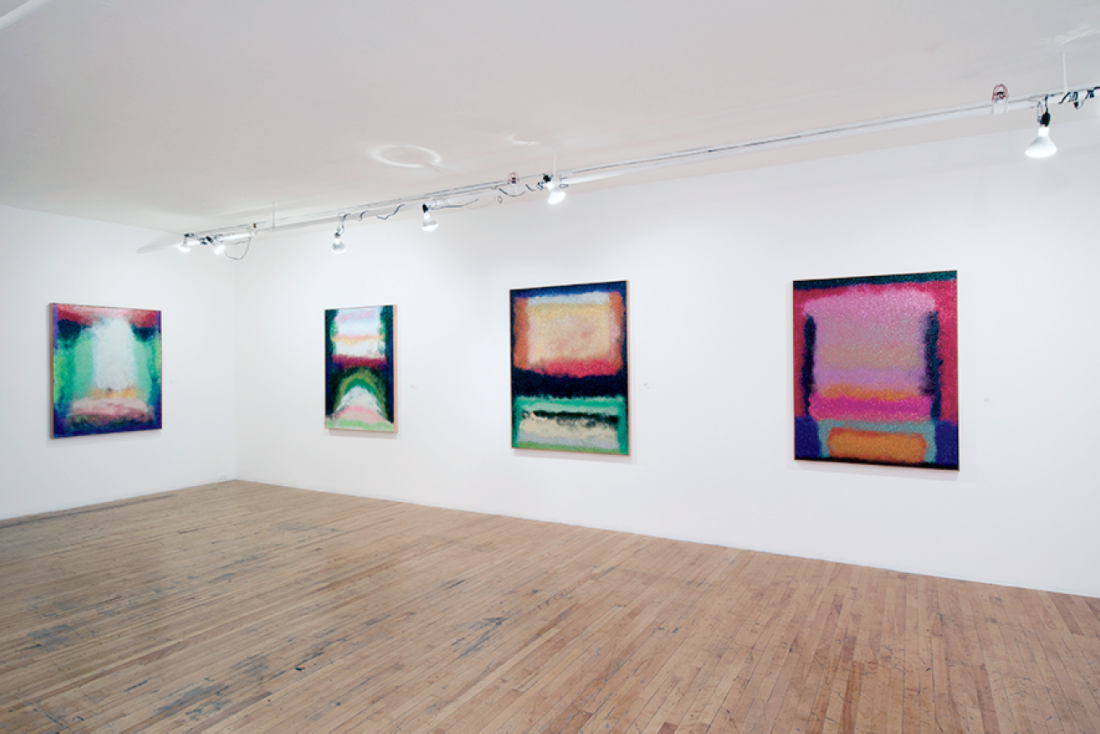Nika Fontaine
A lot of baggage can be said to attach to the term “spirituality.” In the context of contemporary art, it seems fair to say that bringing spirituality directly into the conversation is rare, and for many reasons is generally considered to be maladroit, even inappropriate. Putatively, we know that many, if not most, people would suggest they have a spirituality of some kind. Probably even those of us who give the matter little thought do as well, to some degree. But any approach to manifesting it in the art world is generally mediated by layers of intellectual presentation and justification. At most, our artwork is expected to theorize our spirituality, not present it straightforwardly, much less embody it.

Nika Fontaine, Schnell schnell #13, 2015, glitter on canvas, 31 x 40 cm. All images courtesy Galerie Joyce Yahouda, Montreal.
Which is why Nika Fontaine’s work is so refreshing. Her exhibition “Heimat” at Galerie Joyce Yahouda in Montreal, curated by Yahouda and François Dell’Aniello, showcases several different but interconnected bodies of work, all of which are self-evidently unafraid of censure for having injected a strong dose of kitschy materials and mystical subject matter—as well as actual mysticism—directly into the matrix of the artwork. Her paintings can even be said to bring kitsch and spirituality into collision, at least for the artist, and to erase the boundaries between them without irony, in the hope that a form of transcendence will take place and become clear and accessible. Her work represents a defiant stance against embarrassment and shame with respect to supposedly respectable art norms, exposing some of their dignified self-regard as potentially rote academicism, perhaps even as arrogance. This is the position Fontaine has staked for herself, and is defending.
The main room of the gallery is occupied by the work Fontaine is best known for in Canada to date, a 2016 series of glitter paintings on canvas called “Schnell Schnell” (the artist is Canadian but lived for several years in Berlin, from where she has exhibited different aspects of her production across Europe). These pieces on first glance recall Mark Rothko, and might seem to be mocking the high seriousness we attribute to his work—but not so, and after looking we can see that Fontaine is attempting to update the immanent sensations many people feel in front of Rothko paintings. Her deployment of the shimmering glitter surface and use of a richly saturated and pleasurable colour palette is visually successful and straightforward, sufficient to convince us that she really means what she is saying. The question is, will we accept the invitation to interact with these paintings in the way she wants her audience to do, or should we just read them in strictly formal terms? It is possible that either way is fine. Still, the pieces do seem to present themselves as possible doorways to altered experience, if not literally to astral projection and subtle embodiment.

Installation view, “Heimat,” 2016, Galerie Joyce Yahouda.
Eyes accustomed to making the rounds in a contemporary art context are generally initiated into a kind of measured understanding, so interacting with this work provides us with a chance to engage with a well-researched, thoroughgoing and rigorous practice that flouts the conventional, polite tropes of painting. Fontaine was a runnerup at the 2016 RBC Canadian Painting Competition for a piece from the “Schnell Schnell” series, but these are not the only interesting paintings in the show at Galerie Joyce Yahouda. Among other significant examples are a pair of large canvases from 2014, a scattershot in a field of figurative imagery across expanses of glittering space. Each of the images, chosen as signifiers and symbols, dares the viewer to read meaning into them, calling on the desire to decipher what hermetic messages they may be weaving together. What do scarabs, flags, musical notation, ice-cream sundaes, barbershop poles, classical columns and devil masks have in common? Maybe nothing, but charged proximity makes them chime with potential hermeneutic possibilities. A number of works from 2015 also hanging in the gallery’s second space are closer to combine, collage painting and use kitsch tropes even more openly. Small and dangling with fringes, bejewelled and adorned with hearts and pendants, they would seem to be curio-shop decorative objects if not for their precise, deliberate finish and careful, serial installation. The longer we spend with these pieces the more a kind of paradoxical sincerity seems to emanate from them, because they actually read as the coldest works in the show, the likeliest to have some sort of ironic message they want to share. Alone in the gallery’s smallest room is Zeta Pupis, 2015, which is basically a purple glitter planet on black velvet, with some carefully painted, tape-like marks near its fringed edges. You can’t get kitschier than this, but it works. After a few moments it’s more like a devotional image than a winking inside joke, and self-aware as well.
An important aspect of this work which became very clear is that in reproduction the work does not present well. While that may be true of most painting to a good degree, there is a particular gulf between looking at these works on a screen or page and seeing the actual painting, one that provides a pleasant surprise. ❚
“Heimat” was exhibited at Galerie Joyce Yahouda, Montreal, from November 24 to December 24, 2016.
Benjamin Klein is a Montreal-based artist, writer and independent curator.

